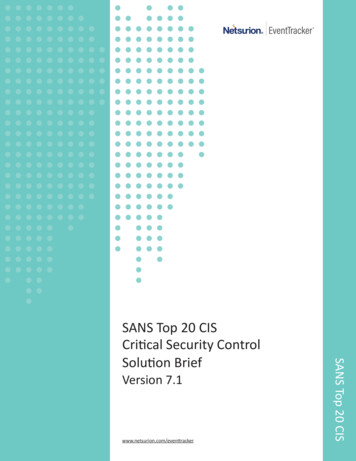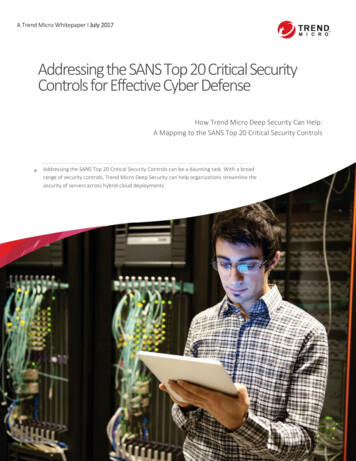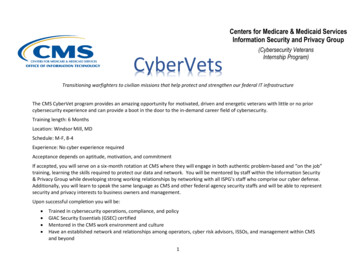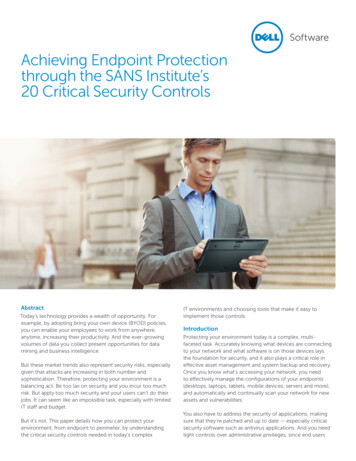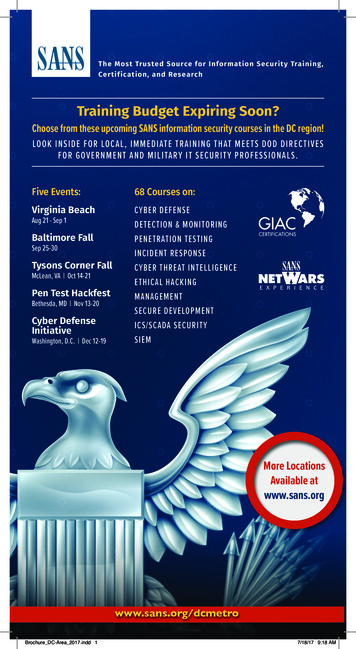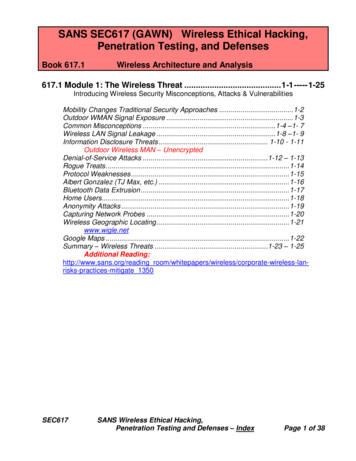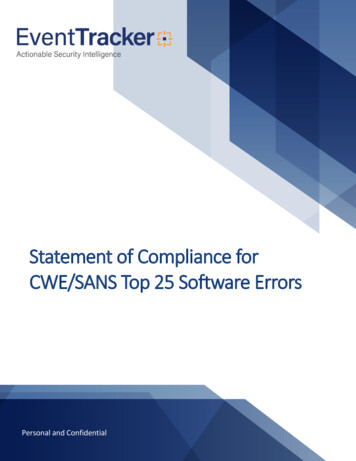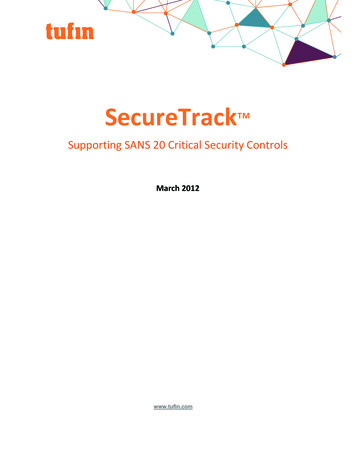
Transcription
SecureTrack Supporting SANS 20 Critical Security ControlsMarch 2012www.tufin.com
Table of ContentsIntroduction . 3Critical Control 4:Secure Configurations for Network Devices such as Firewalls, Routers, andSwitches . 5Procedures and tools for implementing and automating this control . 5How can this control be implemented, automated, and its effectivenessmeasured? . 6Critical Control 5:Boundary Defense . 9Procedures and tools for implementing and automating this control . 9How can this control be implemented, automated, and its effectivenessmeasured? . 9Critical Control 6:Maintenance, Monitoring, and Analysis of Audit Logs . 12Procedures and tools for implementing and automating this control . 12How can this control be implemented, automated, and its effectivenessmeasured? . 12Critical Control 13:Limitation and Control of Network Ports, Protocols and Services . 13Procedures and tools for implementing and automating this control . 13How can this control be implemented, automated, and its effectivenessmeasured? . 13Conclusion . 142/14
IntroductionThe SANS Twenty Critical Security controls is an important initiative designed to consolidate a numberof the most important security standards and initiatives into one, clear set of guidelines. Using theCritical Controls, enterprises can define, monitor and measure their security initiatives more simplyand effectively than before.“The Top 20 Controls were agreed upon by a powerful consortium brought together by John Gilligan(previously CIO of the US Department of Energy and the US Air Force) under the auspices of theCenter for Strategic and International Studies. Members of the Consortium include NSA, US Cert, DoDJTF‐GNO, the Department of Energy Nuclear Laboratories, Department of State, DoD Cyber CrimeCenter plus the top commercial forensics experts and pen testers that serve the banking and criticalinfrastructure communities. The automation of these Top 20 Controls will radically lower the cost ofsecurity while improving its effectiveness. The US State Department, under CISO John Streufert, hasalready demonstrated more than 94% reduction in "measured" security risk through the rigorousautomation and measurement of the Top 20 Controls.”1 The most recent version of the Top 20Critical Controls was released in August 2011 and includes the successful experience of bothgovernment agencies and private organizations. 2Firewalls and related network security devices including routers and switches are a significant part ofthe 20 Controls. Configuring, monitoring, and auditing these devices correctly is essential to assuringcontinuous network security. Tufin Security Suite – SecureTrack and SecureChange – are helpinghundreds of organizations around the world to meet these challenges. SecureTrack ‐ Firewall Operations ManagementTufin SecureTrack is the industry‐leading Security Operations Management solution fornetwork and next generation firewalls as well as network infrastructure including routers,switches, load balancers and web proxies. SecureTrack features powerful tools thateliminate routine, manual tasks while assuring security and business continuity for large andsmall enterprises. SecureTrack – Auditing and ComplianceTufin SecureTrack enables organizations to comply with regulatory standards andsuccessfully pass security audits. SecureTrack combines triggered compliance alerts withbuilt‐in reports such as PCI DSS 2.0 to dramatically reduce audit preparation times. SecureChange ‐ Security Change AutomationTufin’s pioneering SecureChange solution enables companies to automate security changemanagement and risk analysis for the network. With SecureChange, companies can1For the latest version of the 20 Critical Controls, see the SANS web site /. All quotes in this white paper can be found there2SANS press release for the new version: .php3/14
automate business processes to proactively enforce security policies and supportgovernance initiatives.In this paper, we examine the Critical Controls that relate to firewalls and network configurationmanagement, and show you how Tufin enables security teams to fulfill the requirements described ineach control. We will examine the essential role of automated change tracking and compliancemonitoring in assuring continuous security, and at the ways you can proactively analyze and recertifyyour security devices in order to eliminate potential threats.4/14
ControlSolutionControl 4: Secure Configurations for Network Devicessuch as Firewalls, Routers, and SwitchesTufin enables you to maintain a tight configurationfor all of the network devices that control access toyour network.Control 5: Boundary DefenseTufin enables you to improve and verify yourboundary defenses and to safely protect additionalnetwork segments.Control 6: Maintenance, Monitoring, and Analysis ofAudit LogsTufin maintains a complete, segregated audit trailalong with tools for monitoring and analysis.Control 13: Limitation and Control of Network Ports,Protocols and ServicesTufin provides the tools to ensure that access isrestricted and to verify business justification for allaccess.Critical Control 4: Secure Configurations for Network Devices such asFirewalls, Routers, and SwitchesThe 4th control covers the need to maintain a tight configuration for all of the network devices thatcontrol access. This consists of defining a coherent security policy and then continuing to ensure thatall devices continue to comply with this policy over time as changes are made. And since every accessrequest is a potential security loophole, it is essential to verify the business justification for everyexception, and to revalidate that need periodically.Organizations that fail to manage their firewall, router and switch configurations are at risk.“Attackers take advantage of the fact that network devices may become less securely configured overtime as users demand exceptions for specific and temporary business needs, as the exceptions aredeployed, and as those exceptions are not undone when the business need is no longer applicable.Making matters worse, in some cases, the security risk of the exception is neither properly analyzednor measured against the associated business need. Attackers search for electronic holes in firewalls,routers, and switches and use those to penetrate defenses.” 3Procedures and tools for implementing and automating this control“Some organizations use commercial tools that evaluate the rule set of network filtering devices todetermine whether they are consistent or in conflict, providing an automated sanity check of networkfilters and search for errors in rule sets or access controls lists (ACLs) that may allow unintendedservices through the device. Such tools should be run each time significant changes are made to3SANS 20 Critical Security Controls, Control 4 /control.php?id 4 – All quotes in this section are from this control5/14
firewall rule sets, router ACLs, or other filtering technologies.”Tufin Security Suite offers a comprehensive, lifecycle approach to maintaining secure configuration offirewalls, routers and switches. It includes several key capabilities: Corporate compliance policies: SecureTrack gives you a simple way to translate yourcorporate compliance strategy into a concrete policy that you can automatically monitor.Without coding, SecureTrack’s Corporate Compliance Policy enables you to define trafficthat should always be allowed, or always be blocked. You can also define a RiskManagement Policy that specifies either blacklist or whitelist traffic, as well as permittedexceptions. This policy helps you to ensure that no changes are made that post a threat tobusiness continuity. Compliance alerts: Any time a firewall or router configuration change violates the corporatepolicy, an alert is sent out so that you can maintain continuous compliance, without waitingfor the next audit. Compliance reports: You can manually run or schedule periodic compliance audit reportsthat show the current security policy configuration in comparison to the CorporateCompliance and Risk Management policies. Many other reports can be used to audit yoursecurity policy configuration including the Software Version Compliance report, The BestPractices Report, and the Security Risk Report. Policy analysis: Before implementing a change, you can use SecureTrack’s Security PolicyAnalysis to identify possible conflicts or violations. This pro‐active risk analysis tool can savehours of painstaking, manual rule base review. Network topology discovery automaticallyidentifies the relevant devices in a query and makes it easy to define zone‐based queries. Rule documentation and recertification: To keep your security policy up to date at all time,you can document an expiration date and a business owner for each rule. SecureTrack willautomatically alert you to rules that are going to expire so that you can recertify them, ordelete them. You can also schedule reports by expiration date or owner to help manage youraccess rules proactively.How can this control be implemented, automated, and its effectiveness measured?Quick Win, Metric or SensorTufin SolutionQuick wins: Compare firewall, router, and switchconfiguration against standard secureconfigurations defined for each type of networkdevice in use in the organization. The securityconfiguration of such devices should bedocumented, reviewed, and approved by anorganization change control board. Anydeviations from the standard configuration orupdates to the standard configuration should bedocumented and approved in a change controlsystem.Define a corporate compliance policy in SecureTrack thatwill automatically alert to any change that is notcompliant. Periodically use the Software VersionCompliance Report, the Corporate Compliance report,the Security Best Practices Audit, and the Cisco DeviceConfiguration Report (DCR) to ensure that all deviceconfigurations comply with your policy.Quick wins: At network interconnection pointssuch as Internet gateways, inter‐organizationconnections, and internal network segments withIn SecureTrack, create a compliance policy for zone tozone communications and generate automatic alertswhen administrators allow any unauthorized or6/14
different security controls implement ingress andegress filtering to allow only those ports andprotocols with an explicit and documentedbusiness need. All other ports and protocolsshould be blocked with default‐deny rules byfirewalls, network‐based IPS, and/or routers.unapproved traffic or zones. You can create customcompliance policies that define black list, white list andbusiness continuity policies and SecureTrack will makesure that they are enforced continuously.Configuration/Hygiene: All new configurationrules beyond a baseline‐hardened configurationthat allow traffic to flow through networksecurity devices, such as firewalls and network‐based IPS, should be documented and recordedin a configuration management system, with aspecific business reason for each change, aspecific individual’s name responsible for thatbusiness need, and an expected duration of theneed. At least once per quarter, these rulesshould be reviewed to determine whether theyare still required from a business perspective.Expired rules should be removed.SecureTrack’s Rule Documentation and Recertificationenables you to assign a justification, a business andtechnical owner, and an expiration date to every accessrule. You can schedule alerts and reports about expiringrules so that administrators can review their currentbusiness justification and either delete or recertify.Configuration/Hygiene: The latest stable versionof a network device’s inter‐network operatingsystem (IOS) or firmware must be installed within30 days of the update being released from thedevice vendor.Use the Software Version Compliance report to indicatethe correct version that should be installed and checkcompliance on each of the devices on your network.Advanced: The network infrastructure should bemanaged across network connections that areseparated from the business use of that network,relying on separate VLANs or, preferably, onentirely different physical connectivity formanagement sessions for network devices.Use SecureTrack’s Policy Analysis to simulate networktraffic and verify separation of networks.Sensor: File Integrity SoftwareMeasurement: Standard images for theinstallation of systems have been created basedon an accepted security standard published byorganizations such as CIS, NSA, DISA, and others.Score: Pass/FailTufin’s change monitoring automatically detects everychange on every firewall, router and switch along withmany additional devices including IPSs. Every change issaved and reported as part of a comprehensive audit trailwith full accountability.Sensor: Standard imagesSecureTrack can be used to check all of the layers thatcomprise a “standard image” or configuration for asecurity device. First, the Software Version Compliancereport checks that the correct updates are installed onevery device. Second, the Best Practices Audit checksthat every device is configured according to the leadingsecurity standards. For Cisco devices, there is also theCisco Device Configuration report that checks forcommon errors and misconfigurations.Measurement: Standard images for theinstallation of systems have been created basedon an accepted security standard published byorganizations such as CIS, NSA, DISA, and others.Score: Pass/FailYou can also use the Rule and Object usage report toidentify unused rules and objects on each device removethem if they are not longer necessary.On top of these norms, you can define your corporatecompliance policy, and use automatic alerts as well asthe Corporate Compliance report to ensure that devicesare continuously in accordance with your policy.7/14
Sensor: Packet generation toolsMeasurement: Confirm that the networkinfrastructure properly handles, routes and filtersIPv6 traffic.Score: Pass or Fail.Policy analysis enables you to simulate traffic and testyour firewall and router configuration. It tests offline soyou do not have to load your network with test traffic.8/14
Critical Control 5: Boundary DefenseThe 5th control focuses on the importance of establishing secure boundaries at a time when clearphysical perimeters no longer exist. “It should be noted that boundary lines between internal andexternal networks are diminishing as a result of increased interconnectivity within and betweenorganizations as well as the rapid rise in deployment of wireless technologies. These blurring linessometimes allow attackers to gain access inside networks while bypassing boundary systems.However, even with this blurring of boundaries, effective security deployments still rely on carefullyconfigured boundary defenses that separate networks with different threat levels, sets of users, andlevels of control.”4Procedures and tools for implementing and automating this control“The boundary defenses included in this control build on Critical Control 4. The additionalrecommendations here focus on improving the overall architecture and implementation of bothInternet and internal network boundary points. Internal network segmentation is central to thiscontrol because once inside a network, many intruders attempt to target the most sensitivemachines.”Tufin Security Suite can help organizations to comply with this control in two key ways: Policy Analysis: SecureTrack’s sophisticated policy analysis enables you to check networkaccess between any source and destination. Using Network Topology Intelligence, it showsyou all of the devices along the access path on a dynamic, visual map. With Policy Analysisyou can ensure that there is no unjustified access to and from sensitive internal networks. Automatic Policy Generator: SecureTrack’s Automatic Policy Generator (APG) to quickly andsafely deploy firewalls on additional internal network segments without threateningbusiness continuity. APG analyzes network traffic logs and designs a firewall policy thatallows only the traffic that is actually required.How can this control be implemented, automated, and its effectiveness measured?Quick Win, Metric or SensorTufin SolutionQuick wins: Organizations should denycommunications with (or limit data flow to)known malicious IP addresses (black lists) or limitaccess to trusted sites (white lists). Tests can beperiodically carried out by sending packets frombogon source IP addresses into the network toverify that they are not transmitted throughnetwork perimeters. Lists of bogon addresses(unroutable or otherwise unused IP addresses)are publicly available on the Internet fromvarious sources, and indicate a series of IPDefine a Compliance Policy in SecureTrack that includesblack list and white list traffic. Use the compliance alertsto notify about any configuration change that couldviolate the policy. Schedule the Compliance Audit reportto periodically run and verify that all firewalls and routersare configured correctly.4SANS 20 Critical Security Controls, Control 5 /control.php?id 5 – All quotes in this section are from this control9/14
addresses that should not be used for legitimatetraffic traversing the Internet.Visibility/Attribution: Define a networkarchitecture that clearly separates internalsystems from DMZ and extranet systems. DMZsystems are machines that need to communicatewith the internal network as well as the Internet,while extranet systems are those whose primarycommunication is with other systems at abusiness partner. DMZ systems should nevercontain sensitive data and internal systemsshould never be directly accessible from theInternet.Define a zone‐based Compliance Policy that ensures thattraffic from the internal network cannot pass to theinternet. Use the automatic alerts and reports to verifythe network design and ensure that configurationchanges do not violate the design in real time.Visibility/Attribution: Design and implementnetwork perimeters so that all outgoing web, filetransfer protocol (FTP), and secure shell traffic tothe Internet must pass through at least one proxyon a DMZ network. The proxy should supportlogging individual TCP sessions; blocking specificURLs, domain names, and IP addresses toimplement a black list; and applying white lists ofallowed sites that can be accessed through theproxy while blocking all other sites. Organizationsshould force outbound traffic to the Internetthrough an authenticated proxy server on theenterprise perimeter. Proxies can also be used toencrypt all traffic leaving an organization.With Policy Analysis, you can verify that no sensitiveprotocols go directly from the internal network to theinternet, but pass through a proxy. Implement thesetests as a compliance policy and use alerts and scheduledreports to enforce the policy and ensure continuouscompliance.Configuration/Hygiene: Organizations shouldperiodically scan for back‐channel connections tothe Internet that bypass the DMZ, includingunauthorized VPN connections and dual‐homedhosts connected to the enterprise network andto other networks via wireless, dial‐up modems,or other mechanisms.Use Policy Analysis to verify that there are no back‐doorconnections to the firewalls.Configuration/Hygiene: To limit access by aninsider or malware spreading on an internalnetwork, organizations should devise internalnetwork segmentation schemes to limit traffic toonly those services needed for business useacross the internal network.With the Automatic Policy Generator, you can implementfirewalls on additional network segments that have anon‐permissive policy yet do not threaten businesscontinuity. Use Rule Documentation to add a businessjustification to ever access rule and to trigger alerts forexpiring rules that require recertification.Configuration/Hygiene: Organizations shoulddevelop plans to rapidly deploy filters on internalnetworks to help stop the spread of malware oran intruder.Using policy analysis can help you to plan where to installthose changes, effectively assuring that when they aredeployed, they are 100% effective.Advanced: To minimize the impact of an attackerpivoting between compromised systems, onlyallow DMZ systems to communicate with privatenetwork systems via application proxies orUse Policy Analysis and a Compliance Policy to ensurethat the DMZ can only access proxy servers.10/14
application‐aware firewalls over approvedchannels11/14
Critical Control 6: Maintenance, Monitoring, and Analysis of Audit LogsThis control focuses on the need for thorough, meticulous logging of security systems and the abilityto analyze those logs to identify both threats and security events. “Deficiencies in security logging andanalysis allow attackers to hide their location, malicious software used for remote control, andactivities on victim machines. Even if the victims know that their systems have been compromised,without protected and complete logging records they are blind to the details of the attack and tosubsequent actions taken by the attackers. Without solid audit logs, an attack may go unnoticedindefinitely and the particular damages done may be irreversible.”5Procedures and tools for implementing and automating this controlIn the realm of firewalls and routers, Tufin SecureTrack maintains a complete audit trail of everyconfiguration change that is made to every device configuration, rule base, or ACL through a read‐only connection. SecureTrack’s audit trail provides detailed information about every change includingfull accountability on the part of the administrator who made the change. This change record isstored in the SecureTrack database separated from the device maintaining an independent securityaudit trail along with the complete device configuration.SecureTrack includes several reports including the Best Practices report and the Cisco DeviceConfiguration Report (DCR) that check that other devices are set to log correctly.With the Automatic Policy Generator (APG), SecureTrack also analyzes firewall traffic logs to locateoverly permissive rules that may be abused by hackers. It proposes new, tighter rules based on actualusage traffic that can permit network traffic without preventing access for justified business needsand eliminate unnecessary access that was granted by old access rules.How can this control be implemented, automated, and its effectiveness measured?5Quick Win, Metric or SensorTufin SolutionVisibility/Attribution: Each organization shouldinclude at least two synchronized time sources(i.e., Network Time Protocol ‐ NTP) from which allservers and network equipment retrieve timeinformation on a regular basis so thattimestamps in logs are consistent.The Cisco Device Configuration Report (DCR) checks toverify that your device is configured to the proper NTPservers.Visibility/Attribution: Network boundarydevices, including firewalls, network‐based IPS,and inbound and outbound proxies, should beconfigured to verbosely log all traffic (bothallowed and blocked) arriving at the device.The Best Practice Report includes a check for “rules withno log tracking” across all firewall controls/control.php?id 612/14
Critical Control 13: Limitation and Control of Network Ports, Protocolsand ServicesControl 13 addresses the need to protect remotely accessible services and applications. “Attackerssearch for remotely accessible network services that are vulnerable to exploitation. Commonexamples include poorly configured web servers, mail servers, file and print services, and domainname system (DNS) servers installed by default on a variety of different device types, often without abusiness need for the given service. Many software packages automatically install services and turnthem on as part of the installation of the main software package without informing a user oradministrator that the services have been enabled. Attackers scan for such issues and attempt toexploit these services, often attempting default user IDs and passwords or widely availableexploitation code.”6Procedures and tools for implementing and automating this controlSecureTrack’s sophisticated policy analysis enables you to check network access between any sourceand destination. Using Network Topology Intelligence, it shows you all of the devices along the accesspath on a dynamic, visual map. With Policy Analysis you can identify the services that can be accessedfrom untrusted networks as well as the presence of internal firewalls.With Rule Documentation and Recertification, you can document the business owner and justificationof each network access rule along with an expiration date. Alerts and reports will let you know whenrules are expiring so that you can review business justification for access regularly.How can this control be implemented, automated, and its effectiveness measured?6Quick Win, Metric or SensorTufin SolutionVisibility/Attribution: Any server that is visiblefrom the Internet or an untrusted networkshould be verified, and if it is not required forbusiness purposes it should be moved to aninternal VLAN and given a private address.Use SecureTrack Policy Analysis to identify the serversthat are visible from an untrusted network. To validateand maintain business justification for visible servers, useRule Documentation and Recertification to identify thebusiness owner, and Rule and Object Usage Analysis tomake sure that the access is being used.Configuration/Hygiene: Services needed forbusiness use across the internal network shouldbe reviewed quarterly via a change controlgroup, and business units should re‐justify thebusiness use. Sometimes services are turned onfor projects or limited engagements, and shouldbe turned off when they are no longer needed.See section ntrols/control.php?id 1313/14
Configuration/Hygiene: Operate critical serviceson separate physical host machines, such as DNS,file, mail, web, and database servers.Use SecureTrack Policy Analysis to check these services.This check is standard in the PCI DSS compliance report.Advanced: Application firewalls should be placedin front of any critical servers to verify andvalidate the traffic going to the server. Anyunauthorized services or traffic should beblocked and an alert generated.Use Policy Analysis to verify that critical services are allbehind application firewalls. With Palo Alto NetworksNext Generation firewalls, you can use Policy Analysis toverify that application filtering is in place for criticalservices.ConclusionThe SANS 20 Critical Controls are a valuable tool for evaluating the efficacy of your securityoperations and for defining a roadmap for ongoing improvement. A number of the controls areconcerned with the configuration, monitoring and auditing of firewalls and other network securityinfrastructure. Tufin Security Suite is an essential solution for organizations that need to assuresecurity and compliance for networks. It includes automation capabilities that enable you to track andaudit every network configuration change, with full personal accountability. It gives you the in‐depthanalysis tools that you need in order to proactively evaluate risks and eliminate potential securityloopholes. Given the complexity of today’s networks – the number of devices, the size of rule basesand ACLs, and the assortment of vendors – it is virtually impossible for security teams to managedevice configuration manually.Around the world, hundreds of customers are using Tufin Security Suite to improve security,streamline operations, and assure compliance with standards. Customers report that on average,Tufin cuts the time and cost of change management and auditing in half. It eliminates the routine,painstaking manual tasks that not only take up valuable time, but can lead to potentially dangerouserrors. According to Frost & Sullivan, SecureTrack can reduce audit preparation time by as much as75% ‐ and just as important, can enable you to be continuously compliant.For more information about Tufin and how it can help you to comply with the SANS 20 CriticalControls, visit us at www.tufin.com. Copyright 2015 TufinTufin, Unified Security Policy, Tufin Orchestration Suite and the Tufin logo are trademarks of Tufin. All other productnames mentioned herein are trademarks or registered trademarks of their respective owners.14/14
3/14 Introduction The SANS Twenty Critical Security controls is an important initiative designed to consolidate a number of the most important security standards and initiatives into one, clear set of guidelines.


